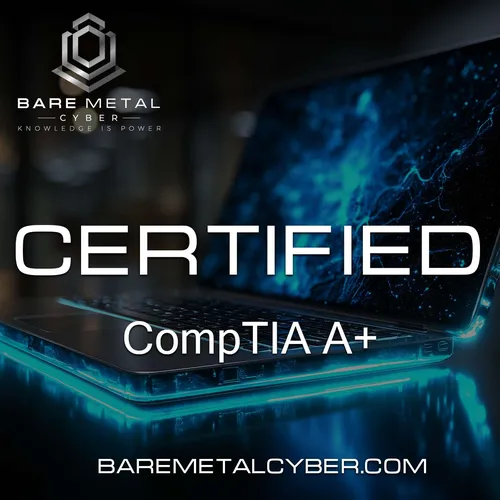
Certified - The CompTIA A+ Audio Course
The A+ Audio Course is your full-spectrum audio study guide for the CompTIA A+ certification (Core 1 and Core 2). Whether you're brand new to IT or brushing up before exam day, this podcast breaks down every topic in the official exam objectives into clear, structured, and accessible episodes. Each lesson focuses on what matters most—helping you understand, retain, and apply essential IT concepts, from hardware and networking to operating systems, security, troubleshooting, and professional procedures.
Designed for listening on the go, the A+ PrepCast covers over 130+ exam-focused episodes, including detailed walkthroughs, glossary deep dives, and domain-specific overviews. Episodes are crafted to support both visual and auditory learners, and align perfectly with the latest CompTIA exam version. Whether you're commuting, exercising, or prepping between classes, the A+ PrepCast turns your time into certification momentum. Brought to you by BareMetalCyber.com.
- Update frequency
- every day
- Average duration
- 12 minutes
- Episodes
- 140
- Years Active
- 2025

Episode 40: Fiber Optic and Direct Burial Cables
This episode dives into advanced cabling types used in high-speed and long-distance network infrastructure: fiber optic and direct burial cables. We start with fiber optic cables, explaining the diff…

Episode 39: Shielded, Coaxial, and Plenum Cabling
This episode extends your knowledge of cabling by focusing on three specific types often overlooked: shielded twisted pair, coaxial cable, and plenum-rated cable. We explain when to use shielded twis…

Episode 38: Ethernet Cabling — Cat 5 through Cat 6a
Ethernet cables are the physical backbone of modern networks, and this episode focuses on the different categories of twisted-pair cabling you’ll need to recognize. We explain the differences between…

Episode 37: Domain 3.0 Hardware — Overview
This episode introduces the third domain of the Core 1 exam—Hardware—arguably the most hands-on and detail-heavy section of the certification. We outline what’s covered, from motherboards, CPUs, and …

Episode 36: Network Tools — Crimper, Punchdown, Toner, Analyzer
In this episode, we look at the physical tools that IT technicians use to install, test, and troubleshoot network cables and infrastructure. We start with crimpers, explaining how they're used to att…

Episode 35: SOHO IP Configuration — Static, Dynamic, Gateways, APIPA
This episode covers the small office/home office (SOHO) networking environment with a focus on IP configuration methods. We begin by distinguishing between static and dynamic IP addressing, explainin…

Episode 34: Internet Appliances, SCADA, and IoT Devices
As networks expand into more than just traditional computing devices, this episode explores the role of internet-connected appliances, industrial control systems like SCADA, and the rapidly growing w…

Episode 33: Networked Host Services — DHCP, DNS, Print, AAA
Host services are critical to how devices function on modern networks, and this episode explains the most essential ones covered on the exam. We begin with D H C P—how it dynamically assigns IP addre…

Episode 32: Bluetooth, NFC, RFID, and Long-Range Wireless
This episode explores a set of wireless technologies that extend beyond traditional Wi-Fi, many of which play crucial roles in mobile and IoT environments. We begin with Bluetooth—covering pairing mo…

Episode 31: Wi-Fi Standards — 802.11 a/b/g/n/ac/ax
This episode provides a deep dive into the evolution of Wi-Fi standards, focusing on the specific versions tested in the Core 1 exam: 802.11 a, b, g, n, a c, and a x. We begin by explaining how each …

Episode 30: Wireless Frequencies and Channels — 2.4 GHz vs. 5 GHz
Wireless communication relies on specific frequency bands and channel structures, and this episode breaks down exactly how they work in the context of Wi-Fi networking. We begin by explaining the 2.4…

Episode 29: Cable Modems, DSL, ONTs, and Interfaces
This episode dives into the technologies that bring internet service into homes and small offices—focusing on cable modems, DSL, and fiber-based Optical Network Terminals, or ONT s. You’ll learn how …

Episode 28: Firewalls, NICs, SDN, and PoE
In this episode, we explore a variety of hardware and software technologies that control traffic, enable communication, and deliver power across network devices. We begin with firewalls—both hardware…

Episode 27: Access Points, Hubs, Patch Panels
This episode covers three often-confused networking components that play very different roles: access points, hubs, and patch panels. We start by explaining how wireless access points bridge Wi-Fi tr…

Episode 26: Routers and Switches — Managed vs. Unmanaged
Routers and switches are the backbone of every network, and this episode breaks down how each one functions and differs in an enterprise or home setting. You’ll learn that routers operate at Layer 3 …

Episode 25: TCP vs. UDP — Connectionless and Connection-Oriented
This episode explains one of the most fundamental networking concepts tested on the A Plus exam: the difference between Transmission Control Protocol and User Datagram Protocol. We begin with TCP’s k…

Episode 24: Common Ports and Protocols — FTP, HTTP, DNS, RDP
Understanding common network ports and protocols is essential for both the A Plus exam and real-world troubleshooting. This episode dives deep into the most important ones—such as File Transfer Proto…

Episode 23: Domain 2.0 Networking — Overview
Networking is one of the most critical domains in Core 1, and this overview episode sets the stage by introducing the topics covered under Domain 2.0. You’ll get an outline of what CompTIA expects yo…

Episode 22: Touchpads and Drawing Pads
Touchpads and drawing pads are common input devices found on laptops and used by graphic professionals, and the A Plus exam expects you to understand both. This episode begins with touchpad technolog…

Episode 21: Docking Stations and Port Replicators
In this episode, we explore docking stations and port replicators—two essential technologies that expand the functionality of laptops in business and multi-monitor environments. You’ll learn how dock…